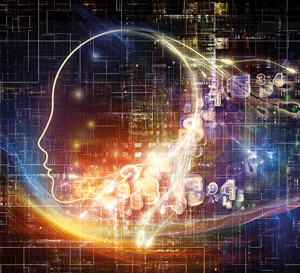A.I. Threat or Opportunity

As a youth, my friends and I read magazines like "Young Technician", "Quantum", "Science and Life", along with sci-fi novels by Sheckley, Bradbury and Asimov. Even so we could not imagine how quickly artificial intelligence (AI) would become such an integral part of our daily lives.
I always liked to do something with my hands, and once in grades 4-5, I decided to build a robot. It was made of plywood, and almost my height. The robot was equipped with a vibration motor (brushes for clothes as his feet plus eccentric motors), so that he could move. His eyes were light bulbs with a conical reflector made from a tin can. He raised his hand when you came closer to him, thanks to a photo diode reacting to changes in lighting which was built into his chest.
And most importantly, he was able to speak - with my voice! To do this I disassembled my parents’ state-of the-art cassette recorder, a Sputnik 401 (terribly expensive and scarce in those days) and embedded it into the robot. When I recall how I sawed and soldered, I wonder whether the thought occurred to me that I would be involved in the creation of artificial intelligence technology when I grew up?
The world's first tentative steps in artificial intelligence - technology that thinks and makes decisions like a human - were made in the middle of the 20th century. Today, AI is present in many and various forms: speed cameras, robotic vacuum cleaners, voice assistants, sensors for unmanned vehicles, text and voice recognition software.
The Associated Press, the international information and news agency, is already making 3000 financial statements per quarter with the help of AI. Analysts estimate that by 2025 robots that act as financial advisors, and will manage a budget of 7 trillion dollars. More and more technologies are emerging each day based on neural networks and deep machine learning.
Progress in the field of deep learning, deep neural networks and parallel computing has played a major role in the breakthrough development of artificial intelligence. Since 2010-2012, the development of deep neural networks has been skyrocketing. Hundreds of scientific articles are published on a daily basis, and technologies which only appeared 6 months ago are already considered obsolete.
New achievements in AI are announced literally every month. More recently, Google AlphaGo beat the world champion in Go, a very complex ancient Chinese board game. 10 million people professed their love for the girl, Xiaoice, a chat-bot created by Microsoft, which was later invited onto China's Morning News TV show.
It is believed that the desktop PC will rival the human brain for its productivity by 2030–2040. The technological singularity will be achieved, when a computer will become smarter than a human, and therefore will begin to improve itself faster and better than a human.
A reasonable question that worries many people is whether there will still be a need for human professions, when AI learns to perform more tasks and takes over many roles? According to scientists at Oxford University, about 47% of US jobs are at risk of being fully replaced by technology by 2025.
White House financial experts forecast that AI will replace all workers that make less than $20 per hour. Thus, it seems like there will be 350 million production or warehouse employees out of work. There are already 30,000 robots working in Amazon's warehouses, saving the company both time and money.
The American bank Merrill Lynch predicts that automation will reduce labor costs by 9 trillion dollars. Another 8 trillion will be saved in the processing industry and healthcare; autonomous vehicles and drones will bring 2 trillion more. In general, the influence of AI on the economy due to production automation is estimated at $US33 trillion . According to report from Bank of America (http://bit.ly/2a42LiQ), robots and AI may increase the productivity by 30% in many industries, while reducing labour costs by 18-33%.
Even more AI
All of the above excites one’s imagination. Currently, there are hundreds of thousands of engineers all over the world working to improve machines and AI technologies. In Silicon Valley, investor interest in these technologies is unparalleled.
In the second quarter of 2016, the share of investments in AI increased in comparison with other major areas of focus (e.g., digital medicine). By June 2016, more than 200 companies focused on AI had attracted more than $US1.5 billion. The number of investment transactions funding such startups has increased 6-fold over the past few years, from 70 in 2011 to 400 in 2015.
AI technology is encouraging the creation of a vast number of brand new products and markets.
Examples are easy to find. Thanks to Realty Editor (http://www.realityeditor.org/), we can control physical objects, such as lighting devices, technology, or a vehicle, with our smartphone. All we need to do is point the smartphone camera at an object created on the Open Hybrid platform.
One very interesting project, The AIVC (http://www.theaivc.com/), is actually the first venture investment fund that evaluates startup ideas using AI technology!
Another example, Kensho (https://www.kensho.com/) responds to financial questions and analyses the market. IBM Watson analyses patient data, compares it with the accumulated medical knowledge base and helps doctors determine the correct diagnosis. On 05 August 2016, the Japanese Cancer Center reported that Watson established a diagnosis of a rare form of leukemia, a task that professional doctors failed to accomplish.
Api.ai (https://api.ai/) is a service that provides all the tools for implementing communication platforms to third-party applications. Alterrа (http://alterra.ai/en/) chooses a country for your next vacation, while startup Luka (https://luka.ai/) generates a dialogue with users on the basis of neural networks. Cubic robotics (http://cubic.ai/) is an intelligent butler for house management.
The hugely popular Prisma app (http://prisma-ai.com/) stylises photographs as if they were made by famous artists, and has won the hearts of 50 million users around the world in just a few months.
My company, ABBYY, is also into AI development. Text recognition technologies are already being used to extract relevant data from documents and speed up the filling in of fields. ABBYY Compreno is able to understand the meaning of text. It allows banks to receive a borrower's information and make sound credit decisions. It speeds up the technical support process and can respond to a client directly (or direct a client to a proper tech support engineer). It helps HR with routine work such as reviewing CVs, extracting required potential candidate information and matching data with job descriptions.
The Findo project, one that I am working on currently, is also AI-based and helps to find necessary files, letters, and personal documents based on their description in natural language (for example, "find me a healthy diet presentation from the person I met in Boston").
The system aims to solve the eternal problem: you know you have a file, yet cannot find it. Findo is an intelligent search agent that will not just recognise language (at the moment, it is English only) but also act as an assistant, for instance to notify you that you received an urgent request from your boss and haven't responded to it yet.
A place for humanity?
So, is it likely that half us will be unemployed in less than 10 years? I don’t think so. Even if machines take over some of the current functions performed by humans, the demand for labour will remain. In the 1980s, the United States introduced barcode scanners and POS terminals. This reduced labour costs in stores, but the cashiers are still around. Between 1980 and 2013, their employment grew by more than 2%.
There is still a huge gap between what many people are doing at work, and what robots and AI can do. It is relatively easy to automate everyday tasks, but there are many non-standard challenges which machines cannot manage.For example, there are many routine tasks which seem easy for humans, but are impossible for a machine. This phenomenon is known as Moravec's paradox. To fold a towel, a person needs only a few seconds. In 2010, a robot performed this task and it took nearly 25 minutes. From this we may conclude that that cooks, gardeners, plumbers, and dentists won’t be replaced by AI in the near future. All of these jobs are associated with sensorimotor skills and many of them require brainstorming, recognition of huge volumes of images, and making insights.
It is quite difficult for AI to perform work that requires the development of interpersonal relationships. Machines have weak social skills. They will not be able to perform tasks associated with human interaction, such as, for example, motivation, psychological support and care. This means that the jobs of sales staff, managers, and entrepreneurs, nurses and kindergarten teachers are probably safe.
Mankind has always been distinguished by the ability to think creatively, a difficult quality to teach to a machine. While AI technologies may take on mundane tasks, we will continue to think creatively and, for instance, write poetry. Digital technologies may complement this, but in no way will it supplant it.
According to Eric Brynjolfsson, an MIT economist and one of the authors of "The Second Machine Age", these are the best of times for creative people, those who develop something innovative, whether it’s a song, film, service or software.
AI may automate routine tasks but it also opens up new markets which previously could not be imagined.
The US Labor Department predicts that 1.2 million new jobs will emerge by 2020, related solely to computer technology. Someone needs to develop and maintain these machines. The Harvard Business Review has named data scientist as the most attractive and in-demand profession of the 21st century.
In addition to industry-specific professions, new jobs will add to the technological ecosystem. For example, a lawyer in robo-ethics, a human body designer, an engineer for natural environment restoration, a space guide, and many others.
Today, teachers train humans in programming and development, but there will also be a need for those who train machines. It is not enough to train a machine to use AI to perform the work of a human. New operating instructions must be thoroughly described – a task that can only be performed by those whose jobs will be subsequently replaced by robots. So new roles will evolve.
According to McKinsey Global Institute (MGI) analysts, society will develop 10 times faster and 300 times more extensively in the near future, thanks to achievements in AI development.
This will provide unlimited opportunities to develop new products, services, businesses, and revolutionise workplaces since people will have new tasks and challenges.
What an interesting time we live in! We just need to adapt to modern times, prepare to adapt to new, more popular professions, and learn key competencies that no robot or algorithm can replace. Ultimately, I believe that despite all the technological advances, humans will always remain humans. Our main role is to continue our own DNA.
 David Yang is a co-founder of ABBYY, the leading developer of document recognition, data capture and linguistic software. He holds an M.S. in Applied Mathematics and Physics, is the author of a large number of scientific publications and holds many patents.
David Yang is a co-founder of ABBYY, the leading developer of document recognition, data capture and linguistic software. He holds an M.S. in Applied Mathematics and Physics, is the author of a large number of scientific publications and holds many patents.
